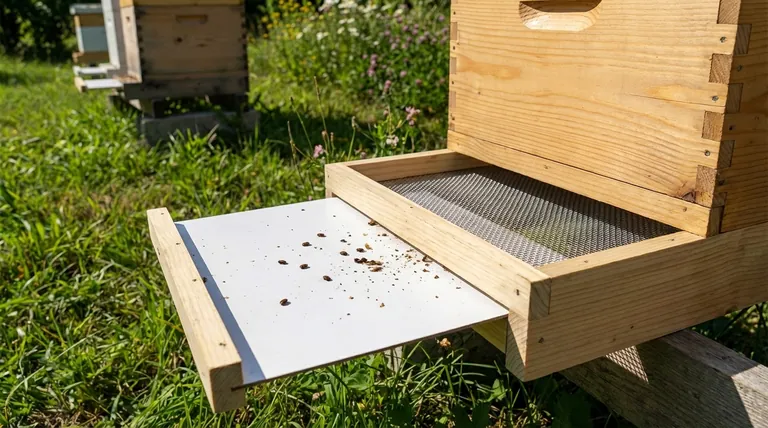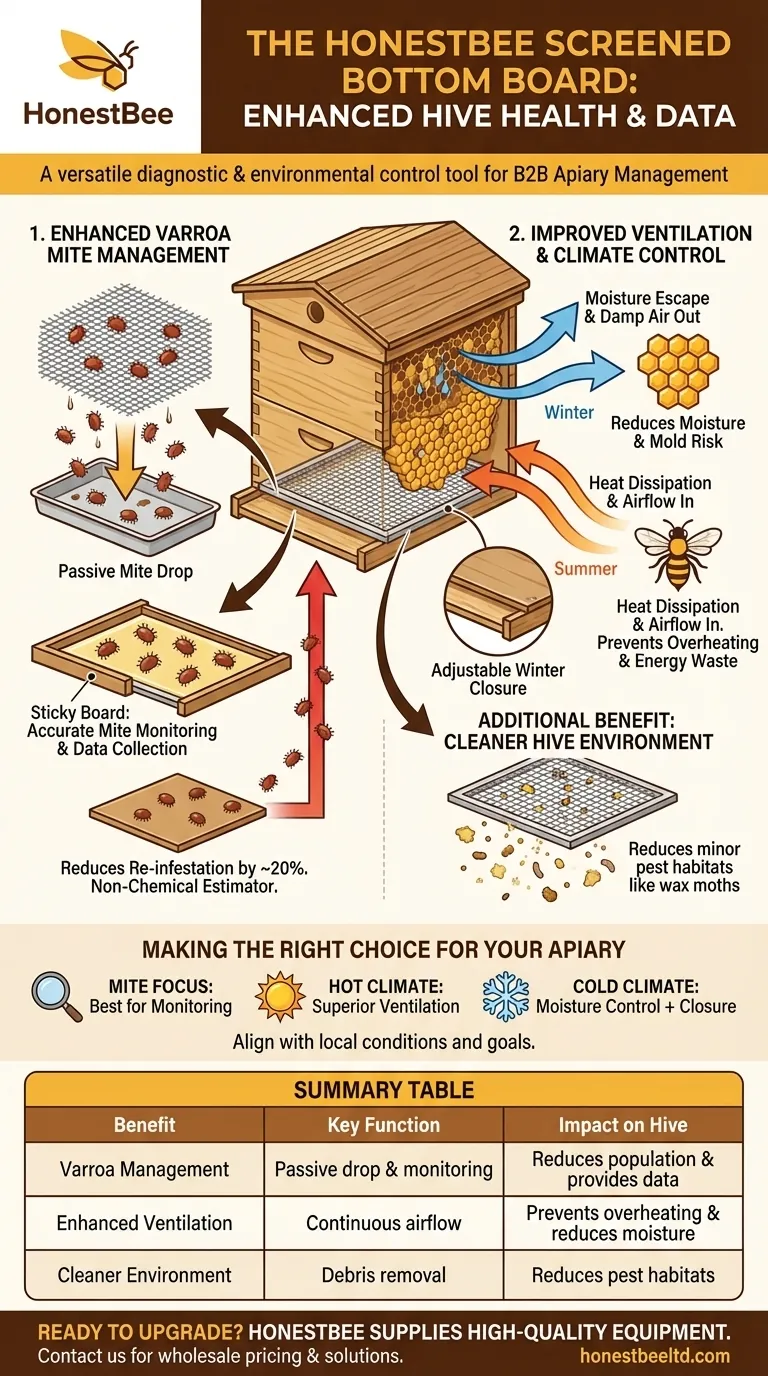In short, a screened bottom board offers two significant benefits beyond a standard solid board: enhanced hive ventilation and a simplified method for managing and monitoring Varroa mites. These advantages work together to create a healthier internal hive environment and provide the beekeeper with critical data for colony management.
The core value of a screened bottom board is not as a standalone solution, but as a versatile diagnostic and environmental control tool. It empowers beekeepers to passively monitor pests and actively manage temperature and moisture with greater precision.

The Two Pillars of a Screened Bottom Board
A screened bottom board fundamentally changes the hive's floor from a solid, enclosed surface to a ventilated, semi-permeable one. This design directly influences hive health through pest management and climate control.
Enhancing Varroa Mite Management
The most frequently cited benefit is its role in a Varroa mite management strategy. The screen allows mites that fall off a bee's back to drop completely out of the hive.
Without a screen, these mites can simply fall to the bottom board and climb back onto another bee, re-infesting the colony. This "mite drop" provides a passive, non-chemical reduction in the hive's overall mite population, estimated to be around 20%.
Crucially, it also functions as a monitoring tool. By sliding a coated "sticky board" under the screen for a set period, you can capture and count the fallen mites. This gives you an accurate, low-stress estimate of the infestation level without having to open the hive and disturb the colony.
Improving Hive Ventilation and Climate Control
The screen provides continuous, passive airflow through the hive. This ventilation is beneficial in both hot summers and damp winters.
During hot months, the increased airflow helps prevent the colony from overheating. This reduces the energy bees must expend fanning to cool the brood nest.
In cold, damp winters, the ventilation helps reduce moisture buildup. As bees cluster and respire, they produce significant water vapor. A solid bottom board can trap this moisture, leading to condensation, mold, and chilled bees. A screened board allows this damp air to escape, keeping the hive drier and healthier.
A Cleaner Hive Environment
A minor but helpful benefit is hive cleanliness. Small debris, such as wax cappings, pollen dust, and other hive detritus, can fall through the screen. This helps keep the bottom of the hive cleaner, reducing potential habitats for other minor pests like wax moth larvae.
Understanding the Trade-offs and Limitations
While beneficial, a screened bottom board is not a perfect solution for every situation. Its effectiveness depends on your climate and management style.
It Is Not a Standalone Mite Treatment
The passive mite drop is a helpful supplement, but it is not an effective primary treatment for a significant Varroa infestation. It must be integrated into a comprehensive Integrated Pest Management (IPM) plan that includes other, more active treatments when mite counts reach threshold levels.
The Risk of Over-Ventilation
In colder climates, the constant airflow can be a disadvantage during the coldest parts of winter. The colony may have to expend more energy and consume more honey to keep the winter cluster warm.
For this reason, most screened bottom boards are sold with a removable solid insert or "closure panel." This panel can be slid in to block the screen, effectively turning it back into a solid bottom board when heat conservation is more important than ventilation.
Potential for Pheromone Disruption
Some argue that the increased airflow can cause a faster dissipation of queen pheromones and other chemical signals bees use to communicate. While this is a theoretical concern, its practical impact is generally considered minimal in most beekeeping operations.
Making the Right Choice for Your Apiary
A screened bottom board is a tool, and its use should align with your specific goals and local conditions.
- If your primary focus is easy mite monitoring: A screened bottom board with a sticky board insert is one of the best diagnostic tools you can have.
- If your primary focus is managing a hot climate: The superior ventilation is a major advantage for reducing heat stress on your colonies.
- If your primary focus is managing a cold, damp climate: Use the screen for summer ventilation and to control winter moisture, but be prepared to use the closure panel during the coldest periods to help bees conserve heat.
Ultimately, a screened bottom board provides a layer of environmental control and diagnostic insight that a solid board cannot offer.
Summary Table:
| Benefit | Key Function | Impact on Hive |
|---|---|---|
| Varroa Mite Management | Passive mite drop & easy monitoring with sticky board | Reduces mite population & provides infestation data |
| Enhanced Ventilation | Continuous airflow through the hive floor | Prevents overheating in summer & reduces moisture in winter |
| Cleaner Environment | Allows debris like wax cappings to fall out | Reduces habitats for minor pests like wax moths |
Ready to upgrade your apiary's health and efficiency?
HONESTBEE supplies high-quality screened bottom boards and other essential beekeeping equipment to commercial apiaries and distributors. Our durable designs help you manage hive climate and monitor pests effectively, leading to stronger, more productive colonies.
Contact HONESTBEE today to discuss wholesale pricing and how our equipment can benefit your operation.
Visual Guide

Related Products
- Australian Pine Wood Langstroth Screen Bottom Board for Wholesale
- Langstroth Screen Bottom Board for Beekeeping Wholesale
- HONESTBEE Wooden Bee Escape Board with Triangle Mesh Design for Beekeeping
- HONESTBEE Durable Frame Wiring Board with Integrated Tensioner
- HONESTBEE Professional Frame Wiring Board and Jig
People Also Ask
- What are the steps to install wire mesh as a floor in a beehive? A Guide to Better Ventilation & Mite Control
- What are the assembly options for the Cypress Screened Bottom Board? Ready-to-Use for Immediate Hive Health
- What are the pros and cons of a screened bottom board? Optimize Hive Health for Your Climate
- How does a screened bottom board benefit the hive during the summer? Boost Ventilation & Pest Control
- What features does the screened bottom board with insert offer? Essential Tools for Hive Health and Pest Control



















